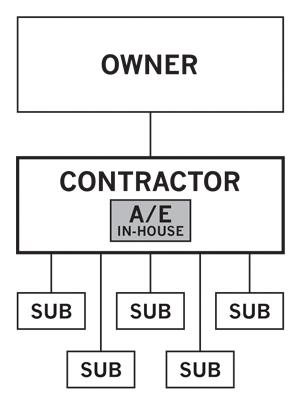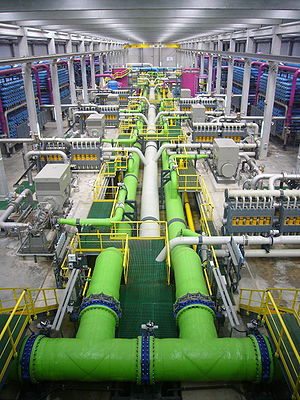There are a number of ways to procure design and construction services for a commercial building project. The predominant approaches are design-bid-build (DBB) and design-build (DB). The former is the practice of hiring a design team (architects and engineers) to develop a set of documents upon which multiple construction teams bid for the work. The latter, the focus of this discussion, involves the owner selecting a prime contractor or construction manager who takes responsibility for the design and construction. In some cases the contractors and their subcontractors (such as the mechanical subs) directly employ licensed personnel who provide design services; in other cases the prime and/or subcontractor hires design consultants to provide design services.
The DB process1 offers some clear potential advantages for certain owners. Liability lies with one entity, the prime contractor. There should be no errors and omissions claims or change orders since the construction team is building their own design. In addition, the project schedule can be positively impacted since there is an opportunity to begin construction before the design drawings are fully complete and there is no bidding and negotiation period before breaking ground. Finally, project budgets can be easier to manage. Typically, the design build team is contracted to provide design and construction for a fixed cost right at the start of the project. This greatly limits the likelihood of a budget overrun because the designing contractor is acutely aware of the cost implications of his or her design decisions.
Because DB contract costs are usually developed before the design is even started, this provides an incentive to the DB engineering team to develop a design that results in the lowest first cost to them, thereby increasing the company’s margin. There’s nothing wrong with that in theory. In my DB commissioning experience, this approach typically results in designs that do not take advantage of cost effective energy systems and equipment that are more frequently included in DBB projects and could be included in the DB project within the Owner’s budget. Here’s my solution to this problem.
THAT FIRST STEP IS A DOOZY!
What’s the first step? Early involvement by an experienced, well qualified Commissioning Authority (CA) – before you solicit DB bids. Independent, 3rd party commissioning is a process that helps ensure the owner’s expectations for success are clearly conveyed, recognized and acknowledged, then executed successfully. Very early involvement by a CA is important for DBB projects but it’s crucial to those that use the DB approach.
To start, the CA can help the owner clearly articulate the project goals and expectations. This document needs to be specific, but not restricting2, allowing some flexibility to the DB team. This document must be provided with the bid documents and the selected DB team should provide a narrative, sometimes called a Basis of Design (BoD), of their proposed systems and equipment showing how they align with the owner’s project requirements (OPR) before contracts are signed. Code references, systems and equipment assumptions including efficiencies, as well as climactic and indoor design conditions should be included. Documenting these allows simple, transparent back and forth between the owner and DB team to develop a solid foundation for the project’s implementation.
As the owner’s advocate, the CA assists the owner in developing the project OPR and providing technical expertise to vet the DB team’s proposed solutions. Unless an owner is particularly savvy about mechanical and electrical systems, it’s likely he or she may not know what to include in their OPR and this is where an experienced CA can add value. A properly developed OPR will allow the DB team to respond with enough meaningful detail and information that any reconciliation between the two should be a simple, straightforward process.
Developing and maintaining a solid OPR and BoD throughout the project provides a clear map and concise record of the expected outcome of the project – an important component of recognizing the project’s degree of success.
Since I’m an engineer, I wanted to offer this mathematical representation (The actual magnitude of the exponent is currently being experimentally verified):
(Well developed OPR) + (Thoughtful and complete BoD) = (Great Project)2
DEFINING THE CA’s ROLE
Integrating commissioning with a DB project is especially important as it allows for collaboration between the DB team and the CA. Clearly defining the CA’s role and responsibilities and how they will interact with the DB team is the next step. The CA must be willing to mold their process around the needs of the DB team with regard to schedule and the design methods. DB’s compressed schedules, strict budgets and lack of defined design milestones require a more flexible approach. If you’re a CA, be prepared to bend a little.
The CA’s level of involvement is dependent on the DB contractor’s scope of work as well as their approach. For example, knowing what the intended rigor of design documentation is (general or more specific), when the contractor intends on ordering equipment and when and by whom sequences of operation will be developed are examples of DB team-specific information that will affect the timing and number of design reviews the CA should do.
Once this is known, the CA must work with the DB team to incorporate the important commissioning milestones by clearly articulating at which steps the CA needs to be involved, what is entailed and what support from the DB team will be necessary. Milestones are best kept relative, rather than using specific dates, to allow for adjustments in the project schedule.
Defining the roles and responsibilities of the various team members so expectations are clear and incorporating commissioning into the project schedule are important to the success of DB commissioning.
“DESIGN PHASE” INVOLVEMENT
Meaningful design reviews are the most important part of a CA’s role during the initial stages of a DB project. This is where an owner can realize some big “bang for the buck.” As an example, on a recent DB project I commissioned, the DB team proposed the installation of a constant volume pumping system for a large number of distributed heat pumps. The installation met all the necessary energy code requirements and even performed acceptably within the frame work of a LEED-required energy model. We suggested a variable volume pumping system and offered some strategies to effect that change and the net result was a payback period of less than 2 years (before utility incentives) with the persistent energy savings and reduction in carbon footprint that will endure for the life of the system. The DB engineer didn’t do anything wrong here – they met code and the LEED energy targets, but the constant volume system had a lower first cost than the variable flow system.
The other important role for a CA in the DB process is submittal review. Submittals usually come after the bids have been awarded but in a DB project, the submittals are often part of the design stage to facilitate the early purchase and delivery of equipment. While detailed submittal review typically falls under the purview of the engineer of record, the engineer of record on a DB project usually works for the contractor who is submitting the equipment. A CA reviewing the submittals acts as the owner’s representative providing a needed check to ensure the proposed equipment will meet the owner’s requirements. Submittals are often the first opportunity to see equipment details such as access door sizes for air handlers, efficiencies of fans and pumps and selected options.
Reviewing the design and submittals allows the CA to have input into the design-build process as an independent resource and advocate for the owner.
THE PLAN
- Employ the services of an experienced, knowledgeable commissioning authority early – preferably before retaining your DB team.
- Develop an OPR reflecting the owner’s expectations for the project
- Ask the DB team to develop a BoD to respond to the owner’s OPR.
- Keep these documents live throughout the project.
- Ensure the DB team understands the CA’s role.
- Incorporate commissioning milestones into the DB schedule.
- Have the CA conduct meaningful reviews of the design documents as well as equipment submittals.
- Start building!
1 For the sake of this post, I’m discussion HVAC and electrical design build scenarios.
2 The exception, of course, are things an owner specifically wants, as in a specific manufacturer of equipment.
3 I only talk about the design phase in this post. The CA’s role during construction is very similar to most other projects.




